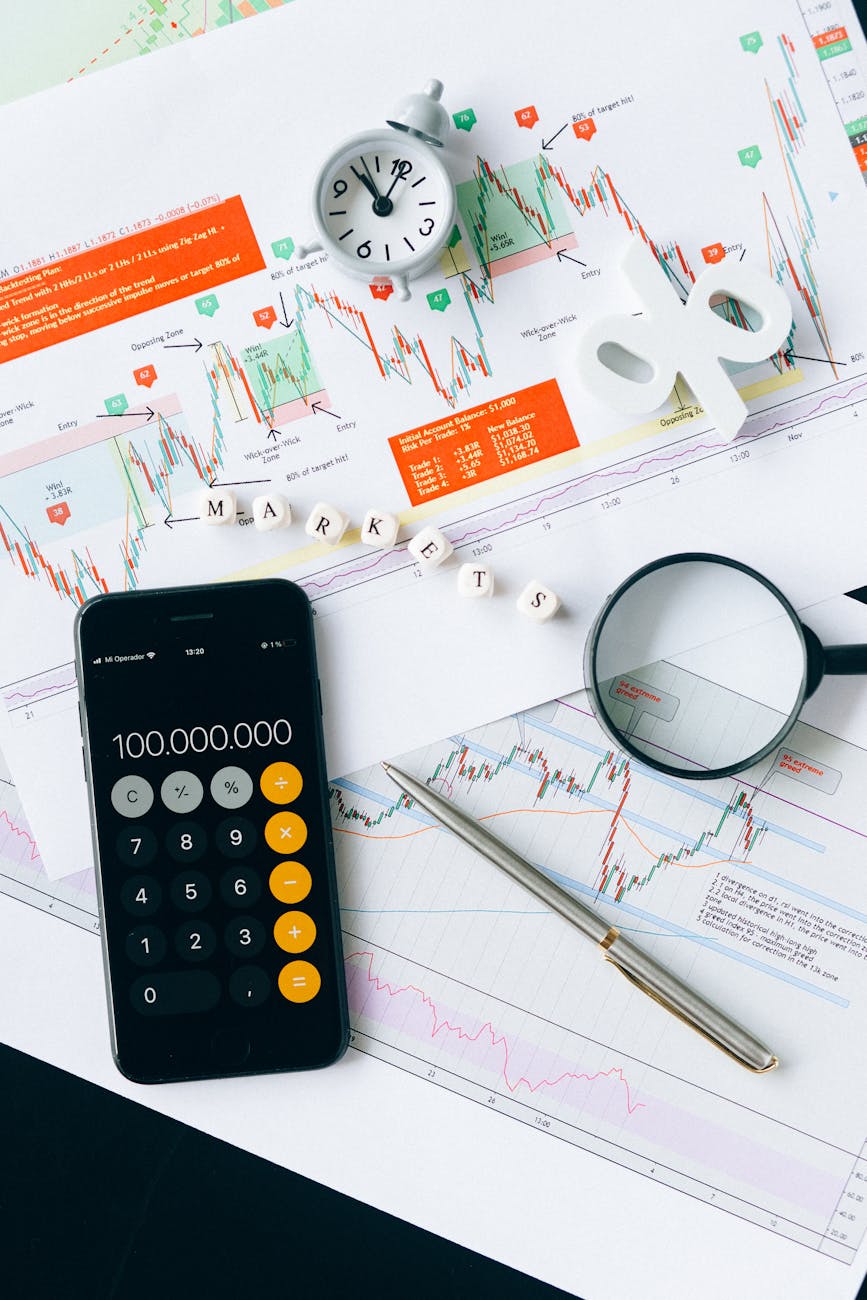Investment Patterns: Bond vs Stocks Popularity
Market Overview
Size and Scope of Bond Market
Many folks think stocks are the big cheese, but the bond market is actually huge. Way bigger than stocks, in fact. As noted by Investopedia, bonds include all kinds of debt – from what Uncle Sam borrows to fund the country to what your local town uses for that new park project. So, it’s a big deal in the financial world. Governments and companies lean on bonds to drum up cash, hence their massive presence.
Back in 2021, the global bond market was sitting pretty at over $128 trillion. That’s a hefty tag compared to the $90 trillion for stocks. Check out the numbers below that make bonds a heavyweight in finance:
| Market Type | Estimated Value (2021) |
|---|---|
| Global Bond Market | $128 trillion |
| Global Stock Market | $90 trillion |
Significance of Stock Market
Stocks are the rockstars of finance. They’re all about buying a piece of a company, which gives you a say in big decisions and a cut of the profits. Stocks are like tiny engines that drive growth and fresh ideas, allowing businesses to snag capital, beef up their operations, and make their shareholders happy. According to NerdWallet, they’ve got a history of solid returns: around 10% each year on average. Even though they come with some jitters, they’re still the go-to for folks chasing bigger gains.
Stocks also give the economy a good pulse check. Indexes like the S&P 500 and Dow Jones are like scoreboards – they show how well or poorly things are going and help investors decide when to jump in or hold back.
If you’re shaking up how you invest, it might be worth checking out how ETFs and index funds stack up against each other.
Importance of Diversification
Let’s not forget the charm of mixing it all up in your investments. A balance between the highs of stocks and the steady ride with bonds is often the ticket to success. Bonds might not have the party vibes of stocks, but they tend to stay cool and collected, helping to smooth out the bumps in your investment journey.
Knowing how these markets play ball with each other can help build a solid investment game plan. And if you’re curious about the showdown between bitcoin vs ethereum popularity or the clash of cryptocurrency vs traditional currency popularity, it’s worth diving into and maybe even stepping outside your comfort zone to explore these financial options.
Ultimately, understanding the nuts and bolts of bonds and stocks highlights why each plays a unique role. By getting a solid grasp on each, investors can tackle the wild financial world with a bit more confidence.
Fundamental Differences
You gotta get the basics down if you’re planning to mix stocks and bonds in your cash stash. Want to know why one might give you a smile while the other just keeps it steady without the drama? Let’s talk about what makes these investments tick – stocks give you a piece of the pie while bonds are like having IOUs from your favorite uncle.
Stocks: Ownership vs. Bonds: Debt
Grabbing stocks is like owning a slice of that hotshot company you believe in. You get a little piece of their world, a claim on some of their stuff and whatever they make on the side (NerdWallet). If they hit the jackpot, you might too, through pocketing extra cash (dividends) or selling those shares for a higher price down the road (capital gains).
Bonds? They’re a different ball game altogether. When you buy a bond, you’re basically lending your lunch money to a company or Uncle Sam expecting your change back with a little extra on top as interest. You’re not buying into the family business, just hoping they pay you every few months. Once the bond matures, you get your cash back, minus the drama of stock price roller coasters.
| Investment Type | Asset Nature | Source of Returns | Investor’s Claim |
|---|---|---|---|
| Stocks | Ownership | Dividends, Capital Gains | Slice of the company pie |
| Bonds | Debt | Regular interest checks, Principal payback | Just a lender (like Clark Kent without the cape) |
Growth Potential of Stocks vs. Fixed Returns of Bonds
Here’s the juicy part: stocks can go up, way up, or they can do the opposite (cue scary music). If you’re the adventurous type and not too worried about your blood pressure, stocks might be your thing. Their value grows when the company is killing it and the economy’s on a roll.
But beware, this isn’t always a straight path. Stocks may be risky and full of surprises. Prices jump up and dive down as if they’re tripping on market news or economic twists and turns.
Now, if you’re a fan of bedtime stories where the outcome’s always the same, bonds might be your cup of tea. They promise steady payments, making them the cuddly blanket for folks who’d rather keep it low-key and secure. By the time you reach the bond’s end, your money’s back in your pocket – neat and tidy like lunch at grandma’s (NerdWallet).
| Investment Type | Growth Potential | Return Type | Risk Level |
|---|---|---|---|
| Stocks | Sky-high (but watch for bumps) | Dividends, Capital Gains | Sky-high (fasten seatbelts) |
| Bonds | Gentle to steady | Regular interest, Principal payback | Smooth sailing (as long as they can’t run off with your money) |
Thinking of mixing it up with your investments? Check out how you can spread things around with portfolio diversification and see what’s what when it comes to comparing ETFs and index funds.
When you get the hang of these money moves, you’ll play it smart with your funds, keeping the wild cards and comfort blankets well balanced in your portfolio.
Performance Analysis
Taking a closer look at past returns is all about getting to grips with how stocks and bonds have fared over the years. Let’s jump into it.
Historical Returns of Stocks
Stocks, or pieces of a company pie, tend to bring home the bacon more than other investments. Don’t just take it from me—since 1928, the stock market’s clocked an average annual return around 10% (NerdWallet). Why so high? Folks investing in stocks want a sweet reward for the risk they take on.
| Time Frame | Average Annual Return (%) |
|---|---|
| Since 1928 | 10 |
| Last 30 Years | 11 |
Grabbed some info from Investopedia.
The stocks’ charm comes from riding the coattails of economic upswings. As the economy (GDP) gets better, so do company profits, which pumps up stock values (Investopedia).
Historical Returns of Bonds
Bonds? They’re like IOUs from companies or the government, with a bit of interest on the side. Generally, bonds give more straightforward but smaller returns than stocks. In the U.S., they’ve shown annual growth of about 4% to 6% since way back when in 1928 (Investopedia).
| Time Frame | Average Annual Return (%) |
|---|---|
| Since 1928 | 4 – 6 |
| Last 30 Years | 5.6 |
Thanks, Investopedia for the facts.
Bonds aren’t as wild as stocks. They’re the comfort food of investments for folks who play it safe. With steady interest over their life span, they’re like a soft cushion during market ups and downs (NerdWallet).
When you stack up stocks and bonds, you get a better sense of the seesaw between risking it and rewards. Feeling curious about other investments? Check out articles on investing in gold and bitcoin vs ethereum drama.
Risk Assessment
Evaluating risk in stocks and bonds ain’t just playing with numbers—it’s the backbone of making smart money moves. Knowing the shaky bits of these assets lets investors figure out the messiness of the financial world.
Stock Investment Jitters
Stock trading is like a rollercoaster ride with no safety belt. Prices swing wildly thanks to crazy things like economic slumps, political drama, and investor mood swings. Plus, the ups and downs of a single company can send shockwaves through its stock prices.
Let’s talk about the scary drop. If a company hits a rough patch or investors lose faith, those share values could plummet, leaving stockholders biting their nails. But hey, despite these nail-biters, stocks have shown some love with better returns than bonds over time—think about 10% a year in the U.S. market.
| Risk Factor | What It Means |
|---|---|
| Market Swings | Wild price jumps due to stuff like economy and politics |
| Company Drama | When a company stinks at its job, share values take a hit |
| Economic Woes | How downturns mess with stock prices |
If you’re curious about cryptocurrencies, blockchain, or the old-school markets, peek at how these risks play out in bitcoin vs ethereum popularity or comparing etfs and index funds.
Bond Investment Blues
Bonds usually play it safer than their stock counterparts. U.S. Treasury stuff has the government’s kiss of security (NerdWallet), so they’re pretty darn safe. But not all bonds have that magical cloak of security. Corporate bonds? Their risk dances to the beat of the company’s financial health. If the company can’t pay, well, its bonds aren’t looking too hot.
Investment-grade bonds keep risks chill while offering nice returns in 2024. Other bonds, like mortgage-backed ones or those connected to credit cards, cars, or student loans, are like treasure hunts for pros who sniff out good buys (Fidelity).
| Bond Type | Riskin’ It |
|---|---|
| U.S. Treasury Stuff | No Worries Here |
| Corporate Bonds | Depends on How Shaky the Company Is |
| Investment-Grade Bonds | Smooth Sailing |
| Mortgage-Backed Bonds | Some Gamble, Some Gain |
Grasping bond risks makes for smarter choices, especially for those diversification buffs. Check out more on managing risks with advantages of investing in gold and cryptocurrency vs traditional currency popularity.
So, while stocks bring high risks due to their wild market rides and company tales, they promise bigger returns. On the flip side, bonds, particularly U.S. Treasury kinds, offer quieter risks with quieter gains. Mixing these up, following the market’s mood and personal risk vibes, shapes up a sharper investment game plan.
Investment Strategy
Creating a solid investment plan means taking a wide lens to weigh various factors. Here, we’re diving into how stocks and bonds stack up against each other. Let’s get real about three key things: mixing up your investments, picking just the right stock-to-bond mix, and how much risk you’re chill with.
Portfolio Diversification
A well-rounded investment pot isn’t just about throwing all your funds into one basket. It mixes different stuff—stocks and bonds, for starters. It’s like not putting all your eggs in one basket; mix it up and you might dodge a nasty fall in the market. Diversification’s that tried-and-true friend who’s got your back when times get tough.
Optimal Allocation of Stocks and Bonds
How you spread out your cash between stocks and bonds? That’s a very personal choice, often swayed by age, future money dreams, and how long you can wait out the ups and downs. If you’re young, with loads of time ahead, you might swing heavily towards stocks—like 80-90% of your dough there, leaving just a smidge for bonds. But as the retirement bell tolls, low-risk bonds start lookin’ mighty comfy.
Example of Optimal Allocation by Age:
| Age Group | Stocks (%) | Bonds (%) |
|---|---|---|
| 20-30 | 80-90 | 10-20 |
| 30-40 | 70-80 | 20-30 |
| 40-50 | 60-70 | 30-40 |
| 50-60 | 50-60 | 40-50 |
| 60+ | 40-50 | 50-60 |
Impact of Risk Tolerance
How adventurous are you with your money? Your appetite for risk really spills the beans on how you balance your stocks and bonds. Stocks might be the rollercoaster—good for thrills and spills with potential big gains, boasting about a 10% average return. Bonds? They’re the carousel, smoother ride with about 6% return (NerdWallet). Getting that mix just right keeps you sailing a steady course as you drift into those golden years.
Example of Risk Levels:
| Investment | Average Annual Return (%) | Risk Level |
|---|---|---|
| Stocks | 10 | High |
| Bonds | 6 | Low |
Your tolerance for risk shapes this whole show—helping you decide how to spread your chips across the table. For more juicy tidbits on this stuff, also check out our reads on comparing etfs and index funds and cryptocurrency vs traditional currency popularity.
Trend Analysis and Predictions
Insights from Historical Trends
Peeking into the past, we see that stocks have made folks wallet-happy with an average annual return of around 10%. Bonds? They’ve been the steady Eddy of the bunch, rolling in a consistent 6%. But here’s the kicker—stocks swing like they’re at a dance party, thanks to their reliance on how big businesses and the economy jive together.
Market Outlook for Stocks
The forecast from J.P. Morgan hints at some roller coaster action for stocks in 2024. If inflation chills out and the economy picks up its dancing shoes, stock prices might shimmy upwards. But beware—the dance floor might get shaky if whispers of a slowdown spook investors (J.P. Morgan). A little GDP boost could be just the playlist stocks need to pump up corporate profits—and in turn, stock prices.
| Year | Average Stock Market Return (%) |
|---|---|
| 2021 | 26.89 |
| 2022 | -18.11 |
| 2023 | 5.81 (Estimated) |
| 2024 | 7.5 (Projected) |
Market Outlook for Bonds
Bonds are looking to be the tortoise in this race, particularly in the latter half of 2024. Safe bet? Investment-grade bonds, which are smoother rides given their low-risk nature. Sectors like mortgage-backed securities are opening doors for savvy asset managers to tap into some sweet returns (Fidelity).
J.P. Morgan also throws a nod towards rising bond prices, nudged up by a dip in inflation and demand. But don’t bet the farm—this stable streak might buckle without some shake-up in interest rates and monetary strategies (J.P. Morgan).
| Year | Average Bond Market Return (%) |
|---|---|
| 2021 | -1.54 |
| 2022 | 3.45 |
| 2023 | 2.22 (Estimated) |
| 2024 | 4.0 (Projected) |
Picking between stocks and bonds is like choosing between a sports car and a family SUV. Each has its charm, but together, they create a ride that’s both thrilling and secure. Do a deep dive into more asset classes by checking out our insights on why gold glitters for investors, and the lowdown on ETFs versus index funds.
Economic Factors
Influence of Interest Rates
Interest rates play a big role when it comes to the dance between bonds and stocks. If rates take a nosedive, bonds usually follow suit in offering less impressive returns. The fixed cash trickle from bonds just doesn’t sparkle next to flashier investments. And yep, in places like Germany and Japan, bonds are practically a guaranteed money funnel – folks actually pay to park their money in these “negative yield” bonds! Wild, right?
| Country | Average Bond Yield (%) |
|---|---|
| Germany | -0.4 |
| Japan | -0.2 |
| U.S. (Treasury Bonds) | 1.5 |
When the numbers dive, investors mosey on over to the stock market, chasing those bigger wins despite upping the ante for risk. But crank up the interest rates, and suddenly bonds look all shiny again with their safer nest egg feel. People start eyeballing bonds, leaving stocks flickering in the rear view mirror.
Now, if rates are cruising uphill, the spotlight swings back to trusty, high-grade bonds. Throw in the Bloomberg US Aggregate Bond Index’s usual 5% yield and corporate bonds tickling at 6%, and you’ve got a tempting morsel for investors craving stability (Fidelity).
Impact of Monetary Policy Changes
The financial rollercoaster is often nudged by central banks, like our good ol’ Federal Reserve. Their moves, whether juggling interest rates or dabbling in quantitative easing (QE), can send ripples through the financial ocean.
Lowering interest rates makes cash flow a breeze, leading to more spending and investing. As a result, stock markets often catch a break as companies get cheaper money to grow. But on the flipside, bonds start looking less appealing when their returns drift south.
Then, if the Federal Reserve bumps up rates, the game changes: higher borrowing costs, but suddenly bonds get their groove back with better yields. Investors tend to lean towards these now-attractive bonds, swerving away from potentially pricier stock investments.
Looking ahead to 2024, there’s chatter that if our money maestros at the Federal Reserve dial down interest rates, bond prices could soar, potentially matching the historical returns linked to US stocks (Fidelity). There’s a chance bonds could become the go-to, outshining stocks and cash in this mixed-up game of financial chess.
For those aiming to max out the potential of their investments, understanding how policy nudges market conditions is a game-changer. Savvy folks can make smarter calls about splitting their dough between stocks and bonds. Get the 411 on mixing it up in your portfolio with our deep dive on comparing ETFs and Index Funds.
Investment Opportunities in 2024
Checking out where to stash your cash in 2024? Bonds might just be your jam, especially if you’re sizing them up against stocks. Let’s jump into why bonds are looking particularly tasty for those who want a steady paycheck from their investments.
Why Bonds Might Beat Stocks
Bonds are the cool cucumber of investments, especially when the economy’s doing its cha-cha. According to the folks at J.P. Morgan Research, next year might see inflation and demand tap the brakes, and that’s music to a bond investor’s ears. Here’s why bonds are giving stocks a run for their money:
- Steady Eddies: Bonds dish out fixed interest payments, soothing that part of you that loves predictability and maybe a little stability thrown in.
- Chill Vibes: Unlike stocks that rollercoaster up and down, bonds usually keep it calm and collected, being gentle with your heart rate.
- Safe and Sound: Bonds from the big players like Fannie Mae and Freddie Mac are like financial hugs that aim to keep your money comfy and safe (Fidelity).
What Can You Expect to Get Back from Bonds?
Sure, bonds aren’t winning the glamour contest against stocks, but they’re solid and reliable. Historians tell us bonds usually give back about 4%-6%, whereas stocks have strutted in with returns between 8%-10% since 1928 (Investopedia). Here’s the lowdown:
| Type of Investment | Historical Returns (since 1928) | Returns Over Past 30 Years |
|---|---|---|
| Stocks | 8% – 10% | 11% |
| Bonds | 4% – 6% | 5.6% |
Hot Stuff for Fixed Income Fans
If you’re in the fixed income club, 2024 might just sprinkle some extra luck into your basket beyond vanilla bonds. Look out for this:
- Mortgage Vibes: Check out the low-risk mortgage-backed bonds from Fannie Mae and Freddie Mac for a safe place to park your bucks.
- Plastic and Rides: Dive into securities tied to credit cards, car notes, and student loans for some sweet deals if you know your stuff (Fidelity).
- Inflation-Proof Picks: As inflation takes a breather, bonds that keep up with any remaining inflation jazz could keep both your nerves and your finances steady.
Throwing some money at bonds could deliver the safety and steady income you crave these days. Make smart moves by finding a balance that suits your style. Get more insider tips with our deep dives into ETFs vs. Index Funds and the perks of gold investments.













